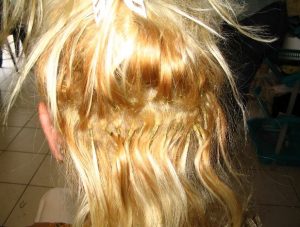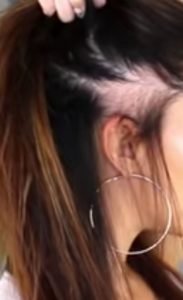What are the best types of hair extensions? Tape-ins, Micro rings, wefts or bonds.
Well, here are a few tips to help you decide.
Micro Rings
Human extension hair is attached with tiny links, sleeves, locs or shells that can match your hair color or be clear. Some of these micro products are made from especially formulated polymer materials. Others are made from flexible nickel tubing that is squeezed shut to hold the hair in place. They are non-magnetic and if made properly, do not rust. If you have a nickel allergy you will not be able to wear them.
Some of these micro methods are used on extremely over processed hair, very fine, silky straight hair and any hair that has trouble holding the adhesive or keratin products used by the other extension methods. The micro shells and links can be re-used sometimes up to three times.



The lady in the above photo had an installation done by an inexperienced technician, who did not dry the client’s hair properly before attaching the links. The metal stayed wet inside the ring and started rusting, causing permanent damage to the client’s hair, also leaving band marks that will eventually snap her hair, at point of attachment.
Tape-ins
This is the most common way of adding extensions without proper training. The tapes come in long sticky strips and gets sandwiched in between a strip of your own hair.
Tape ins is mostly made single drawn, to prevent an even larger damage to the scalp, it makes the hair lighter.
This lower grade of processing does not keep all the hair in one direction & the roots & ends are not separated during processing. In addition, you will find a larger amount (40%) of hair with lengths shorter/longer than the specified length of the bundle. Once processing is complete, both ends of the bundle are cut to improve uniformity. This process is conducive for medium quality wigs, hairpieces, toupees & extensions.


Very visible and hard to hide or create a proper style.


After hours of removing the sticky double sided glue and the obvious damage it has done to the scalp and hair.
The strip eventually starts sliding from heat, putting huge strain on the hair. The sticky substance between the tape-ins is not a glue made specially for hair, it is industrial.
On removing the hair, according to my experience nothing, not even thinners remove the glue from the hair. Pulling most of your own hair out.
Various types of two-sided tape are used to attached hair extension weft or strands.

Wefts
Wefts of extension hair are sewn into tracks created on the head with cornrows. Wefts are re-usable and this system can last 3 – 4 months. Tracks can also be made with hand-tied knots. The extension hair is sewn into the knotted track with a needle and weaving cord.

Drawn is the word used for pulling the hair through an instrument that puts the hairs together (Hackle). It is also called hackling. Single drawn is the 1st hackling of the hair. This puts the hairs together. Similar lengths are gathered 6” to 10”; 11” to 14” and so on. Within the bundles the lengths will be varied. This has to do with how people’s hair grown, falls out and replaces itself. Double drawn is another hackling and a finer separation of the hair. This is much more labour intensive and will just about double the price of the hair. Some hair traders do not double drawing of the hair.

The lady in the above photo's hair was attached with the weaving method.
Be advised that there are some stylists and professionals in the hair extension industry that stress that no hair extensions should be left attached to your hair for more than 10 weeks, as they will cause permanent hair loss if left longer. I have been wearing extensions for nearly 8 years, the period I go with my attachments is 4 months. Hair grows naturally 1cm per month. If the hair is attached by a well trained extensionist it should last up to 4 months.
A Bonding glue adhesive material is brushed into the weft of the extension hair and it is then applied to the root of the individual’s hair.

Clip Ins
Extension hair is clipped directly to hair with tiny hair clips. This is an easy do-it-yourself solution for hair extensions. The hair is purchased with the tiny clips already attached on the ends. Clip-in extensions may be a great place to start if you are serious about getting hair extensions. It can be used to make partial or total extensions, according to the quantity of hair strips applied.

The particular 3 clips clasp allows a fast and practical application and makes asymmetric and trendy hair styles easy. The 2 and 1 clips allow for volume and length on the sides or just to add a few streaks to the hair.
It may take some practice to perfect attaching clip-in hair extensions
Many things can go wrong with hair extensions. They can severely damage the natural hair; even cause permanent hair loss in some cases.
If poor quality hair is used, the result can be severe tangling and matting after several shampoos.
Problems begin when the extensions are not attached properly, removed properly and maintained properly on a daily basis.
With very few exceptions, all hair extensions are a non-refundable service.
Extensionists set aside a huge amount of time to do a full head of extensions.
A reputable extensionist will take care of any concerns or issues a client has regarding hair extensions. If you have done proper training, you will be a reputable extensionist and have nothing to worry about
Fusion

Is this possible with any other of the above methods? Absolutely not.
"Fusion" refers to strand by strand and attachment. The adhesive is a non damaging material that is made up of Keratin. Polyethylene is present in bonds, to form a bonding agent.
Be advised that there are some stylists and "professionals" in the hair extension industry that stress that no hair extensions should be left attached to your hair for more than 10 weeks, as this will cause permanent hair loss if left longer.
With our extensions, experience and bonding methods you can retain extensions for 3 to 4 months without losing your hair.
























